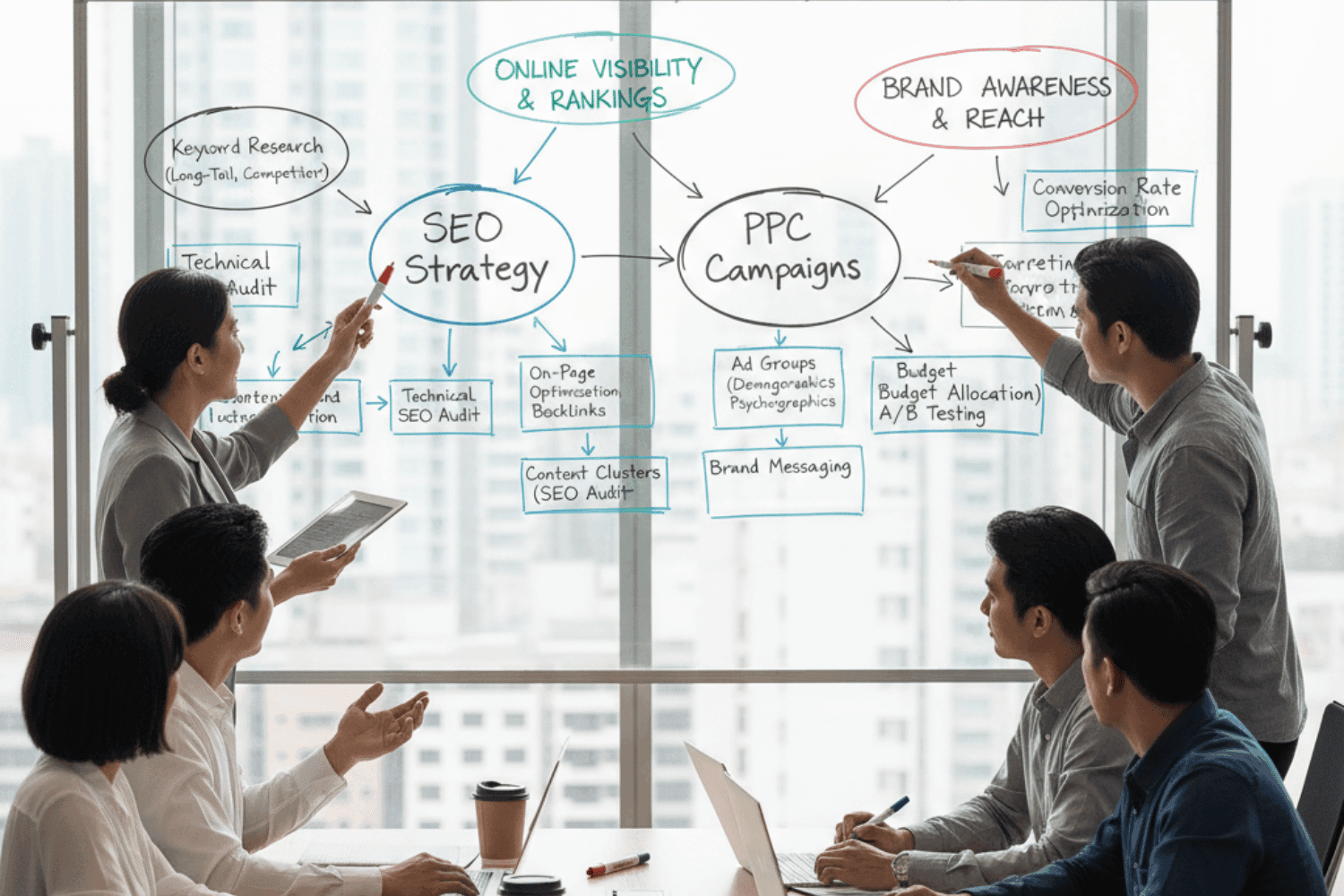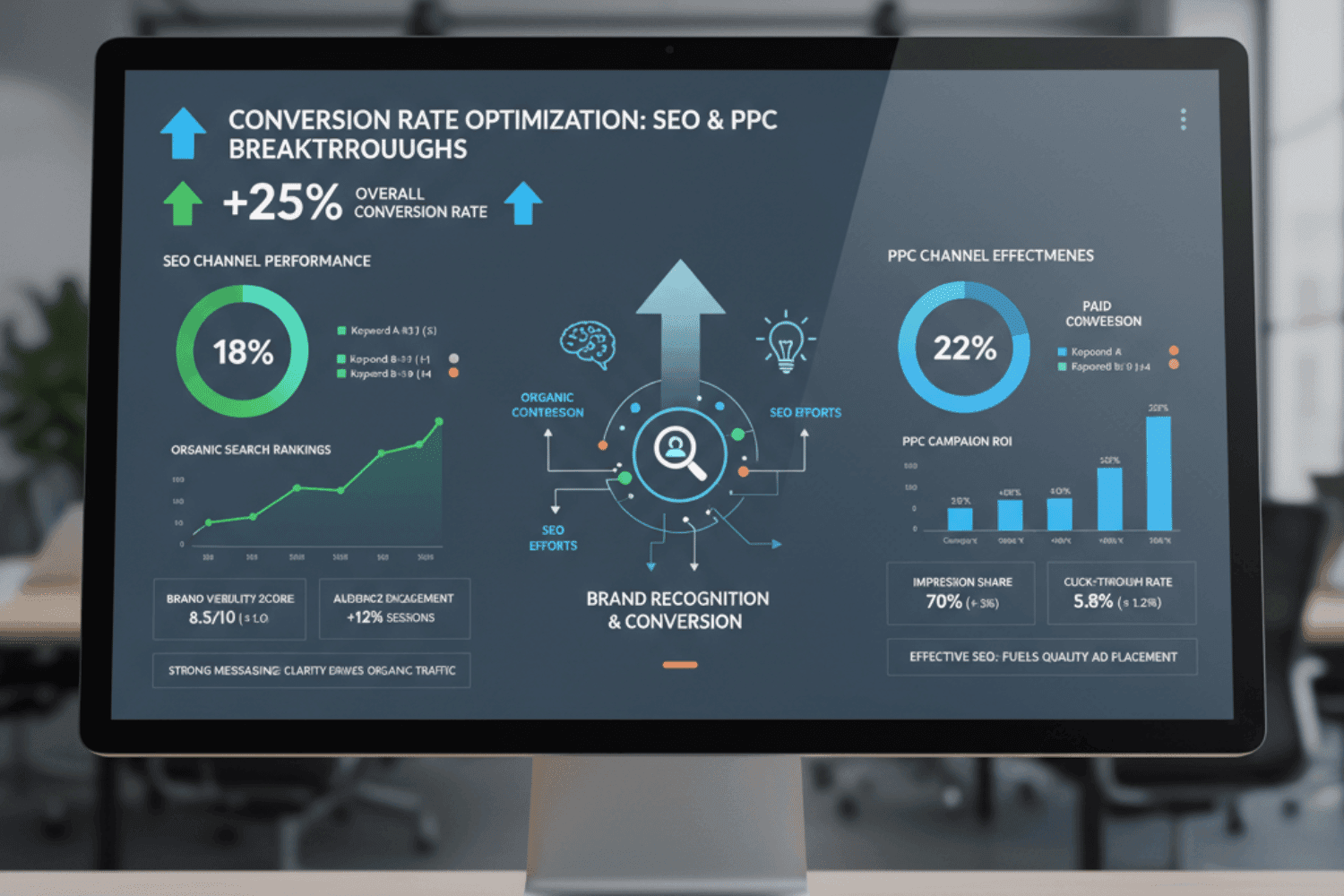The Role of Brand Messaging in SEO PPC Conversion
Key Takeaways
- Consistent brand messaging across SEO and PPC campaigns can increase conversion rates by 23% compared to fragmented messaging approaches
- Brand messaging alignment between organic search results and paid ads creates trust and reduces bounce rates by up to 35%
- Strategic use of branded keywords in both SEO and PPC improves Quality Score and lowers cost-per-click while boosting organic rankings
- Personalized messaging based on search intent and funnel stage can improve conversion rates by 40% in integrated SEO-PPC campaigns
- Unified value propositions across search marketing channels strengthen brand recognition and drive higher lifetime customer value
Understanding Brand Messaging in Search Marketing Context
Brand messaging serves as the backbone of every successful search marketing campaign, yet most businesses treat it as an afterthought. In the context of search engine optimization and pay-per-click advertising, brand messaging represents far more than catchy taglines—it’s the strategic foundation that transforms casual browsers into committed customers.
Your brand messaging encompasses every word, tone, and value proposition that appears across search engine results pages. When a target audience member searches for solutions, they encounter your brand through multiple channels: organic search results, ppc ads, social media posts, and landing pages. Each touchpoint either reinforces your brand identity or creates confusion that kills conversions.


The difference between generic marketing copy and strategic brand messaging lies in consistency and intent. Generic copy focuses on immediate clicks, while strategic brand messaging builds trust that converts across the entire customer journey. Consider how Nike’s “Just Do It” philosophy permeates every search touchpoint—from their organic search rankings for “running shoes” to their ppc campaigns targeting fitness keywords.
This consistency matters more in 2024’s competitive search landscape because search engines increasingly reward authentic, cohesive brand experiences. Google’s algorithm updates consistently favor brands that maintain consistent messaging across web pages, improving both organic traffic and paid campaign performance.
The connection between brand messaging, user intent, and conversion psychology runs deeper than most marketing teams realize. When searchers encounter consistent messaging that speaks directly to their needs, they experience what behavioral psychologists call “cognitive ease”—the mental comfort that leads to action. This psychological principle explains why Apple’s clean, minimalist messaging generates higher conversion rates across both organic search results and ppc campaigns.
How Brand Messaging Impacts SEO Conversion Rates
Your brand’s organic search performance hinges on more than keyword optimization—it depends on how effectively your messaging connects with searcher intent. When your brand messaging aligns with what users actually want to find, you see dramatic improvements in click-through rates, user engagement, and ultimately, conversions.
Effective messaging strategy directly impacts the metrics that search engines use to evaluate content quality. When visitors spend more time on your web pages because your messaging resonates, your dwell time increases. When your brand promise matches visitor expectations, bounce rates drop. These engagement signals tell search engine algorithms that your content deserves higher rankings.
The E-A-T framework (Expertise, Authoritativeness, Trustworthiness) that Google uses to evaluate content quality relies heavily on consistent brand messaging. Small business owners who maintain consistent messaging across their content creation efforts establish authority faster than competitors with fragmented approaches. This consistency helps build brand credibility and improves local search results visibility.
Location-specific brand messaging creates particularly powerful conversion opportunities for local businesses. When your messaging acknowledges local audience’s pain points and speaks their language, you capture more qualified traffic from local search results. Case studies from service-based businesses show 15-30% conversion improvements when they optimize their messaging for local search intent.
Title Tags and Meta Descriptions as Brand Messaging Tools
Your title tags and meta descriptions function as your brand’s first impression in search engine results pages. These elements offer prime real estate for extending your brand messaging while maintaining seo strategy requirements. The most successful brands craft these elements to reflect their unique selling proposition within character limits.
Companies like HubSpot excel at incorporating brand voice into title tags without sacrificing keyword performance. Their titles consistently emphasize their “inbound marketing” philosophy while targeting relevant keywords like “marketing automation” or “lead generation tools.” This approach improves click-through rates while reinforcing brand positioning.
Meta descriptions provide additional space to communicate key benefits and brand personality. Instead of stuffing these descriptions with keywords, focus on extending your brand story in a way that compels clicks. A/B testing messaging variations in search snippets reveals which value propositions resonate most with your target audience.
Mailchimp demonstrates masterful meta description messaging by consistently emphasizing their user-friendly approach to email marketing. Whether targeting “email marketing software” or “marketing automation platforms,” their descriptions always communicate simplicity and effectiveness—core elements of their brand identity.
Content Messaging Optimization for SEO Conversions
On-page content messaging requires balancing authentic brand voice with search engine optimization requirements. The most effective approach involves creating messaging frameworks that guide content creation while ensuring every piece reinforces your brand strategy. Your content should tell your brand story while addressing specific search intents.
Header tags (H1, H2, H3) provide opportunities to incorporate brand messaging while maintaining keyword strategies. Instead of generic headings like “Our Services,” use branded alternatives like “How Our Data-Driven Approach Transforms Digital Marketing Results.” This approach satisfies both search engines and human readers seeking solutions.
Brand storytelling elements improve engagement metrics when woven naturally into informational content. Share customer success stories, explain your unique methodology, or describe your company’s mission within content that targets non-branded keywords. This strategy helps build emotional connection while capturing organic traffic from relevant keywords.


Brand Messaging’s Impact on PPC Conversion Performance
Pay-per-click advertising provides immediate feedback on messaging effectiveness, making it the perfect testing ground for brand messaging strategies. When your brand messaging improves Quality Score through higher ad relevance, you achieve lower cost-per-click rates while reaching more qualified prospects.
Consistent brand messaging differentiates your ppc ads from competitors bidding on the same keywords. While competitors focus solely on price or features, strong brand messaging communicates unique value that justifies premium pricing. This differentiation becomes crucial in crowded ad auctions where multiple businesses compete for attention.
The relationship between brand messaging and click-through rates in paid search extends beyond initial clicks to conversion performance. When your messaging pre-qualifies prospects by clearly communicating what you offer and who you serve, you attract visitors more likely to convert. This selectivity improves both conversion rates and return on ad spend.
Performance metrics consistently show 25-50% conversion rate improvements when businesses implement strategic messaging across ppc campaigns. These improvements stem from better message-to-market fit, where your advertising speaks directly to your target market’s specific needs and preferences.
Ad Copy Messaging Strategies for Higher Conversions
Crafting ad headlines that reflect brand personality while driving clicks requires understanding what motivates your target audiences. Your headlines should communicate your brand promise while incorporating relevant keywords that prospects search for. The most effective ad copy balances brand differentiation with clear value propositions.
Brand messaging in ad descriptions helps pre-qualify leads before they click, reducing wasted ad spend on unqualified traffic. Instead of generic descriptions that appeal to everyone, use messaging that speaks specifically to your ideal customer’s situation. This approach improves conversion rates while reducing cost per acquisition.
Ad extensions provide additional opportunities to reinforce brand messaging through sitelinks, callouts, and structured snippets. Use these extensions to highlight your unique selling proposition, showcase customer testimonials, or communicate your brand’s core values. Consistent messaging across all extension types reinforces brand recognition.
Testing messaging variations for different audience segments reveals which approaches resonate most with specific customer types. Your messaging strategy should adapt based on whether you’re targeting new prospects, existing customers, or competitor audiences. This segmentation allows for personalized messaging that improves conversion performance.
Landing Page Messaging Alignment
Message match between ppc ads and landing pages directly impacts conversion rates and Quality Score calculations. When visitors click your ad and find consistent messaging on your landing page, they experience the cognitive ease that leads to action. Mismatched messaging creates friction that increases bounce rates and reduces conversions.
Brand messaging helps reduce landing page bounce rates by immediately confirming that visitors reached the right destination. Your landing page headlines should echo the value propositions mentioned in your ads while expanding on key benefits. This continuity builds trust and encourages deeper engagement with your content.
Creating conversion-focused headlines that maintain brand voice requires understanding your audience’s decision-making process. Your headlines should acknowledge the problem that brought visitors to your page while positioning your solution as the obvious choice. This approach respects user intent while advancing your business objectives.
A/B testing landing page messaging for different traffic sources reveals how messaging preferences vary across channels. Visitors from organic search results may respond to different messaging than those from ppc campaigns or social media posts. Understanding these preferences allows for optimized messaging that improves overall conversion performance.
Integrating Brand Messaging Across SEO and PPC Channels
Creating unified messaging frameworks requires coordination between seo efforts and ppc strategies to maximize search presence. The most successful businesses develop message strategy guidelines that ensure consistency across all communication channels while allowing flexibility for channel-specific optimization.
Keyword research should inform brand messaging strategies across both organic and paid search channels. When you understand what language your target audience uses to describe problems and solutions, you can incorporate this language into your brand messaging naturally. This alignment improves relevance across all search marketing efforts.


Coordinating messaging campaigns allows brands to dominate search engine results pages through both organic and paid listings. When the same searcher encounters consistent messaging across multiple results, brand recognition increases dramatically. This multi-touch approach builds trust faster than single-channel strategies.
Leveraging data from both seo and ppc channels creates opportunities for continuous messaging refinement. PPC campaigns provide immediate feedback on messaging effectiveness, while organic search data reveals long-term trends in search behavior. Combining these insights creates more effective messaging strategies.
The integration process requires establishing clear timelines and responsibilities across marketing teams. Start by auditing current messaging consistency, then develop unified guidelines that both seo and ppc teams can implement. Regular performance reviews ensure messaging remains aligned with business objectives and market changes.
Branded vs Non-Branded Keyword Messaging Strategies
Branded search terms require different messaging approaches than non-branded keywords because searcher intent varies significantly. When people search for your brand name, they already have some awareness and may be comparing options or seeking specific information. Your messaging should reinforce brand strengths while addressing potential concerns.
Educational messaging works best for non-branded, top-of-funnel keywords where searchers are still identifying problems and exploring solutions. Your brand messaging should position your company as a helpful expert rather than pushing immediate sales. This approach builds trust that converts in later interactions.
Using brand messaging to capture competitor traffic requires ethical approaches that focus on your unique advantages rather than negative comparisons. When bidding on competitor keywords, emphasize what makes your solution different and better without directly attacking competitors. This strategy builds brand credibility while capturing market share.
Balancing promotional and informational messaging across keyword types requires understanding the customer journey stage associated with different search queries. Early-stage queries need educational content that builds awareness, while later-stage queries can include more direct promotional messaging that drives immediate action.
Cross-Channel Messaging Consistency
Maintaining brand voice across organic results, paid ads, and social media requires documented brand guidelines that all team members understand and follow. These guidelines should specify tone, vocabulary, value propositions, and messaging priorities that remain consistent regardless of channel or campaign.
Creating messaging guidelines for SEO and PPC teams prevents the messaging fragmentation that confuses prospects and reduces conversion rates. Your guidelines should include approved language for describing your solutions, standard value propositions, and examples of effective messaging for different scenarios.
Consistent value propositions reinforce brand recognition when prospects encounter your business across multiple channels. Whether someone finds you through organic search rankings, clicks a PPC ad, or sees your social media posts, they should receive the same core messages about what makes your business unique.
Coordinating seasonal and promotional messaging across all search channels ensures maximum impact from marketing campaigns. When your organic content, ppc ads, and social media promote the same seasonal offers using consistent messaging, you create a unified brand experience that drives higher response rates.
Measuring Brand Messaging Impact on Conversion Performance
Tracking the effectiveness of brand messaging requires establishing key performance indicators that capture both immediate conversion impact and long-term brand building effects. Traditional conversion tracking focuses on last-click attribution, but brand messaging impact extends across multiple touchpoints in the customer journey.
Google Analytics 4 and Google Ads data provide insights into how messaging variations affect user behavior across channels. Set up custom events to track engagement with specific messaging elements, and use conversion paths to understand how messaging influences the decision-making process. This data reveals which messages drive the highest-value conversions.
Attribution modeling helps understand messaging impact across touchpoints by assigning conversion credit to all interactions that influence customer decisions. This approach reveals how consistent brand messaging across SEO and PPC creates cumulative effects that improve overall conversion performance.
Setting up conversion tracking for brand messaging experiments requires defining specific actions that indicate messaging success. Beyond basic conversions, track metrics like time on page, page depth, return visits, and brand search volume increases. These indicators show how messaging builds brand awareness and customer engagement.
Performance metrics should include both immediate conversion indicators and longer-term brand equity measurements. Track conversion rate improvements, cost per conversion reductions, and revenue per visitor increases alongside brand recognition surveys and customer sentiment analysis.
A/B Testing Brand Messaging Elements
Testing messaging variations in ad copy, title tags, and landing page headlines provides data-driven insights into what resonates with your target market. Structure tests to isolate specific messaging elements while maintaining statistical significance requirements. This approach reveals which specific words, phrases, or value propositions drive the best results.
Using statistical significance to validate messaging performance improvements prevents premature optimization decisions based on insufficient data. Establish minimum sample sizes and confidence levels before testing, and resist the temptation to end tests early even when results look promising.
Creating testing calendars for continuous messaging optimization ensures systematic improvement over time. Plan tests around business cycles, seasonal trends, and campaign launches to maximize learning opportunities. Regular testing creates a culture of data-driven messaging decisions that compound over time.
Tools like Google Optimize, Unbounce, and VWO enable sophisticated messaging tests across different traffic sources and audience segments. Choose testing platforms that integrate with your existing analytics setup to streamline data collection and analysis. Consistent testing reveals messaging patterns that inform broader brand strategy decisions.
ROI Analysis of Brand Messaging Investments
Calculating return on investment for brand messaging initiatives requires measuring both direct conversion improvements and indirect brand equity gains. Direct ROI comes from increased conversion rates, reduced acquisition costs, and higher average order values. Indirect benefits include improved brand recognition, customer loyalty, and word-of-mouth referrals.
Measuring long-term brand equity impact requires tracking metrics beyond immediate conversions. Monitor brand mention sentiment, share of voice in your industry, and customer lifetime value changes over time. These indicators show how consistent messaging builds brand strength that supports long-term business growth.
Understanding customer lifetime value improvements from better messaging helps justify messaging optimization investments. When brand messaging improves customer satisfaction and retention, the impact extends far beyond initial conversion tracking. Calculate the full value of messaging improvements by including repeat purchase behavior and referral generation.


Benchmarking messaging performance against industry standards provides context for evaluating results. Research industry conversion rate averages, cost per acquisition norms, and brand recognition benchmarks to understand how your messaging performance compares to competitors. This context helps set realistic improvement targets.
Best Practices for Brand Messaging in SEO PPC Conversion
Creating messaging frameworks that scale across search marketing channels requires balancing brand consistency with channel-specific optimization needs. Develop core messaging pillars that remain constant while allowing tactical variations that work best for each platform and audience segment.
Timing messaging updates with algorithm changes and market trends ensures your brand remains relevant and competitive. Monitor Google algorithm updates, industry developments, and competitor messaging changes to identify opportunities for strategic messaging adjustments. Proactive messaging evolution prevents competitive disadvantages.
Building messaging approval workflows prevents inconsistent brand representation across teams and campaigns. Establish clear approval processes for new messaging elements, and create templates that make it easy for team members to create brand-consistent content. This systematization maintains quality while enabling scalability.
Training teams on brand messaging guidelines ensures consistent implementation across all search marketing efforts. Regular training sessions, messaging workshops, and performance reviews keep brand messaging front-of-mind for everyone involved in content creation and campaign management.
Implementation should follow a phased approach that allows for testing and refinement. Start with core messaging updates across high-impact areas like ppc campaigns and key landing pages, then expand to broader content marketing efforts. This approach minimizes risk while maximizing learning opportunities.
Common Brand Messaging Mistakes to Avoid
Inconsistent messaging between organic search results and paid search creates confusion that reduces conversion rates and wastes advertising spend. Audit your current search presence to identify messaging disconnects, and prioritize alignment between ad copy and landing page content. This consistency improvement often produces immediate conversion rate gains.
Over-optimizing for keywords at the expense of brand voice creates robotic content that fails to connect with human readers. While keyword integration remains important for search visibility, authentic brand messaging should always take priority. Search engines increasingly reward content that provides genuine value to users.
Neglecting mobile messaging optimization overlooks the majority of search traffic in most industries. Review how your brand messaging appears on mobile devices, and optimize for the shorter attention spans and smaller screens that characterize mobile user behavior. Mobile-first messaging often requires more concise value propositions.
Failing to update messaging based on performance data and user feedback prevents continuous improvement and market relevance. Establish regular review cycles for messaging performance, and create feedback loops with sales teams and customer service representatives who interact directly with prospects and customers.
Future-Proofing Brand Messaging for Search Evolution
Adapting messaging strategies for AI-powered search features like Search Generative Experience requires understanding how these tools interpret and present brand information. Focus on creating clear, authoritative content that AI systems can easily understand and cite. This preparation positions your brand for success in the evolving search landscape.
Preparing brand messaging for voice search and conversational queries involves optimizing for natural language patterns and question-based searches. Develop messaging that works well in spoken format, and consider how your brand information sounds when read aloud by voice assistants.
Building flexibility into messaging frameworks allows rapid adaptation to market changes without losing brand consistency. Create modular messaging components that can be recombined for different situations while maintaining core brand identity. This flexibility becomes crucial in fast-changing industries.
Incorporating sustainability and social responsibility into search messaging reflects growing consumer expectations for brand values alignment. Develop authentic messaging around your company’s commitment to positive impact, but ensure these messages reflect genuine business practices rather than superficial marketing claims.


FAQ
How long does it take to see conversion improvements from brand messaging optimization?
Most businesses see initial conversion rate improvements within 2-4 weeks of implementing consistent brand messaging across SEO and PPC campaigns. However, the full impact of brand messaging optimization typically becomes apparent over 3-6 months as search engines recognize content consistency and audience familiarity with your messaging increases. PPC campaigns show faster results due to immediate implementation, while organic search improvements develop more gradually as search engine algorithms process your updated content.
Can small businesses compete with large brands through superior messaging in search marketing?
Absolutely. Small businesses often have advantages in creating authentic, focused brand messaging that resonates with specific target audiences. While large brands may have bigger budgets, small businesses can achieve higher conversion rates through more personalized messaging that addresses specific audience pain points. The key is developing a clear unique selling proposition and maintaining consistent messaging across all search touchpoints. Many small businesses see 30-40% conversion rate improvements by implementing focused brand messaging strategies.
What’s the ideal budget split between SEO and PPC when focusing on brand messaging?
The optimal budget allocation depends on your industry, competition level, and business goals, but most successful brand messaging strategies allocate 60-70% to PPC and 30-40% to SEO initially. PPC provides immediate testing opportunities for messaging effectiveness, while SEO investments compound over time. As you identify winning messages through PPC testing, gradually shift more budget toward SEO content creation and optimization to capture long-term organic traffic with proven messaging approaches.
How do you measure brand messaging effectiveness across different industry verticals?
Brand messaging effectiveness varies significantly by industry, requiring vertical-specific metrics and benchmarks. B2B technology companies might focus on lead quality scores and sales cycle length, while e-commerce brands emphasize conversion rates and average order value. Service-based businesses often track consultation booking rates and customer lifetime value. The key is establishing baseline metrics before implementing messaging changes, then tracking improvements in both conversion metrics and brand recognition indicators specific to your industry’s customer behavior patterns.
Should brand messaging strategies differ for B2B versus B2C search marketing campaigns?
Yes, B2B and B2C audiences require different messaging approaches due to distinct decision-making processes and search behaviors. B2B messaging should emphasize expertise, reliability, and ROI potential since purchases often involve multiple stakeholders and longer consideration periods. B2C messaging can be more emotional and immediate, focusing on personal benefits and lifestyle improvements. However, both approaches benefit from consistent brand messaging across SEO and PPC channels—the core values and personality should remain constant while tactical messaging adapts to audience needs.



